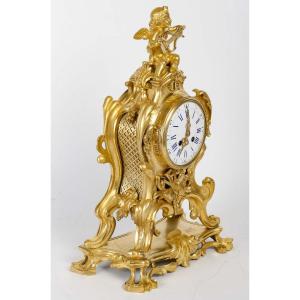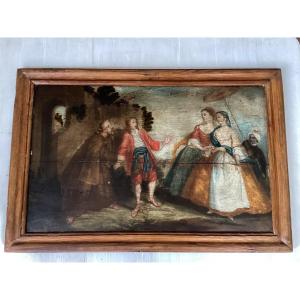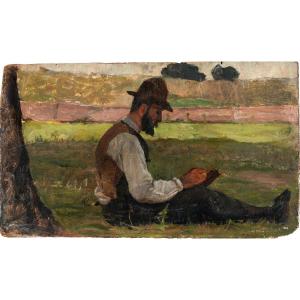--------
Des si charmants Petits Caprices
Respectful of the two paintings that were presented at the Salon des Artistes Français in 1876 and 1878 and established, alongside his "Merveilleuses" (1870), the reputation on the Parisian and international art scene of the Dutch painter Fréderik-HendriK Kaemmerer (The Hague, 1839- Paris, 1902), this charming pair of small paintings restores with a similar flavor the "Retrospective Fantasies" that are his Noces et Baptême (Folkestone, Collection Ian et Jane Bohwell) under the Directoire.
At the sight of these two small and pretty works where we find, more spirited, the pictorial values and qualities characteristic of the manner of this "emeritus" artist "with delicate, prim and gracefully frivolous talent" - the ease of the line, the pleasantness of the background, the shimmering of the bright and cheerful colors, the piquancy of the detail -, "the Curious whose taste has remained faithful to the toilets" of the time of the Incroyables and "the Merveilleuses, will find", as Paul Mantz* noted at the time, "something to recreate". Described by the Salonniers of the time (P. Mantz, Th. Véron, etc.) as "little Jewels", what did these two "scenes of manners from the Directoire period" depict, "painted, drawn and arranged admirably" by Kaemmerer, whose "graceful invention" was to be transposed onto porcelain plaques in 1882 at the Salon des Artistes Francais (no. 3592) by Mlle Angèle May-Daubive?
Her Noces, both playful and sentimental, invites us to follow a dashing wedding procession crossing a very Parisian Tivoli park. Idle strollers are amused by the ballet of proud bicorns, long jackets with basques or fluffy convertible hoods, frilly stoles, sheaths of guests coquettishly dressed. Affable, the newlyweds precede them: considerate, the young man with a slightly demonstrative gallantry has freed from his reticule, fan and bouquet his pretty wife with a more evasive, languid attitude and gaze. Intertwined, they prepare to descend a stony staircase on the steps of which pigeons peck or fly away. Laughing and mischievous is his striking Baptism, the religious ceremony accomplished, on the porch with columns of a Gothic church with steps adorned with "an old yellowish tapestry", precious "miriflores" and "delicate figures from the Directory Period" escorting the newborn. "All glorious in her white burden", a nurse in traditional costume is surrounded on the right by two delightful young women, one of whom "distributes sugared almonds to rascals"; on her left, leaning over, the godfather, a bag of sweets under his arm, the godfather, "smiles" at the sleeping child. In the background, the guests joke, exchanging gallant remarks.
We cannot resist adding to our description the few lines written in 1880 by Paul Hourie* in his article devoted to F. K. Haemmerer, who was then considered the "official portraitist of the elegance of 1793":
"Kaemmerer devoted himself to genre painting, and he fell in love with a beautiful passion, which he knew how to share with everyone, moreover, for the Directory, this period of the renaissance of taste in costume. There is no one who translates more faithfully, who knows how to render its full Spirit better. His "Merveilleuses", his "Baptème", his "Noce sous le Directory" are real jewels of historical reconstruction. What is most pleasing in the painter's talent is the elegant and spiritual turn he knows how to give to all these works (..) The composition has a lot of charm both for the general harmony that reigns there and for the fresh and pleasant tones with which the artist knows how to season them. What surprises us is that with all this spirit that he dispenses and the extreme research that he puts into the choice of his accessories, he manages to move so gracefully in the middle of this period of the Directory, avoiding the pitfall of appearing precious. The reason is undoubtedly (..) the perfect taste that presides over all his arrangements. This taste is the master quality of this delicate talent. Kaemmerer is a Dutchman who, in this respect, is as Parisian as the most refined of our artists".
An assertion that at the dawn of the 20th century Arsène Alexandre*, in view of the artistic career of the painter who tragically died in 1902 in his Parisian studio on rue Vaugirard, formulated in these terms: a student of Jean-Léon Gérôme "who had the good sense not to walk in the shoes and Greek themes of his master", a counterpart of Charles Edouart Delort (1841-1895, Adrien Moreau (1843-1906), Maurice Leloir (1853-1956) dubbed in their time, Kaemmerer was a "sort of Dutch Fortuny who passed through the boulevard de Clichy".
Failing to claim to own a painting by Marià Fortuny or F.H. Kaemmerer, one will experience pleasure and distraction in front of these paintings with piquant details.
*Related literature: Aguillar, Anne -Sophie, Frederik Hendrik Kaemmere (1839-1902) ", in L'Objet-d'Art , n° 121 , February 2018, pp. 38-40;- Alexandre, Arséne, Ombres et Figures: F.H.Kaemmerer, in: Le Figaro Illustré of January 1, 1902;- Hourie, Paul, Kaemmerer, in: L'Estafette of May 31, 1880; -Mantz, Paul, Le Salon de 1872",in: Gazette des Beaux-Arts, January 1, 1872, p. 471 -472.
--------
Materials: oil painting on paper mounted on wood panel; Blackened wood and gilded highlights.
Dimensions: without frame: H.: 12.5 cm; W.: 8.5 cm With frame: H.: 17 cm; W.: 14 cm.
Franco-Dutch school of painting from the second half of the 19th century. Unsigned. Circa 1880
Good condition. Restored paintings; Note: minor accidents to the frames.























 Le Magazine de PROANTIC
Le Magazine de PROANTIC TRÉSORS Magazine
TRÉSORS Magazine Rivista Artiquariato
Rivista Artiquariato
